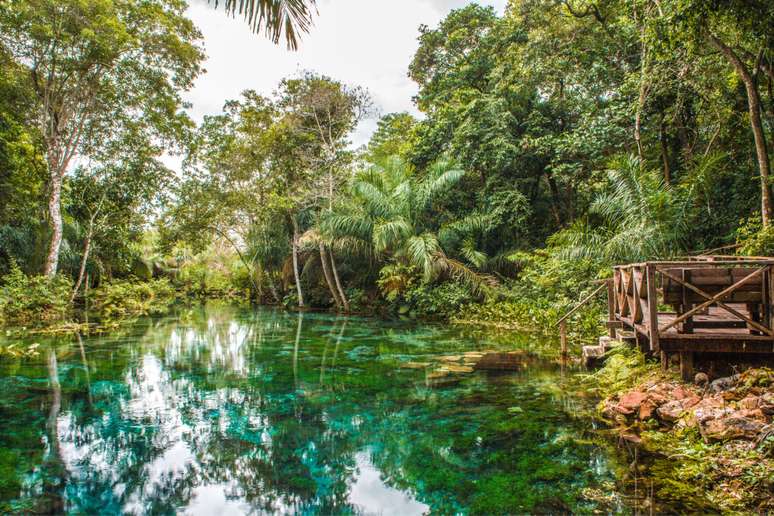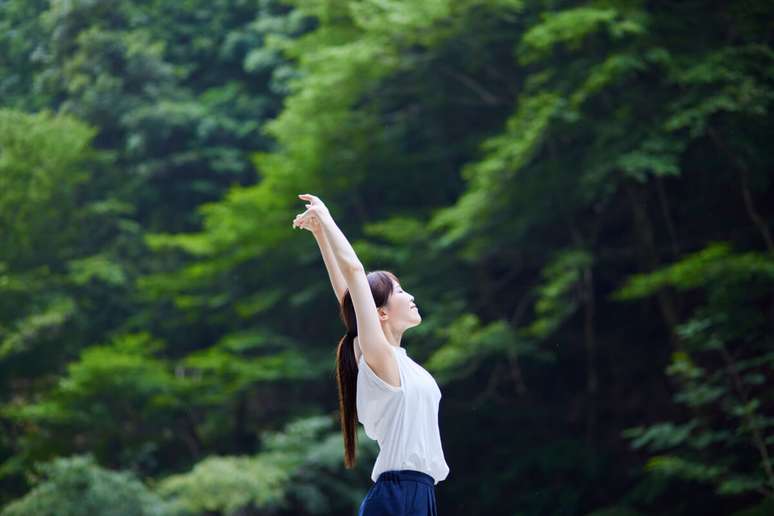Japanese practice reminds us of the importance of connecting with nature
Have you ever heard that story that humanity has separated itself from nature and sometimes even forgets that it is a part of it? If we consider that more than half of the world’s population lives in urban areas and this trend is only increasing, we can imagine that the daily lives of most of us are increasingly distant from the natural world.
With the exception of indigenous peoples and traditional native communities, whose culture keeps them in constant contact with diverse ecosystems, the rest of the population today lives among buildings, asphalt and traffic noise. And not without consequences. Unfortunately.
The effects of this lack of nature We have been noticing this for decades, even if there is a common sense among us that believes it is advantageous to spend time away from the chaos of the city, enjoying a small house in the countryside or a quieter beach. It was precisely this idea, in fact, that took hold in Japan in the early 1980s, when the population’s stress level was alarming.
The government itself drew up an emergency plan and began encouraging people to leave their homes and practice shinrin-yokuor forest Bathing, as well as supporting research on the possible benefits of contact with areas rich in vegetation on people’s health.
The recipe: one hour of forest bathing a week or 20 minutes three times a week. Thus, in a short time, what was previously a supposition or a mere empirical (and even obvious) observation also acquired scientific proof.
Shinrin-yoku: What is Japanese forest bathing?
Pioneer in the field, the Japanese doctor Qing Li, author of the books Shinrin-yoku: The Japanese art of forest therapy (Editora Nascente, 2018, Portugal) e Forest Bathing: How Trees Can Help You Find Health and Happiness (Penguin Life, 2018), among others, often states that the simple habit of visiting parks or taking regular walks in green areas already brings physical and psychological benefits and helps to fight what he considers the epidemic of the 21st century: the stress.
But forest bathing, of oriental origin, goes further: it is a meditative practice that involves the idea of full awareness, mindfulness, whatever name is given to it. It’s different than going to the beach or take a trace with your cell phone in your hand or with your headset. It implies rootedness, belonging, presence.
And it’s no news that researchers are studying nature’s impacts on human health. In the same decade, in 1984, the world scientific community had access to a study conducted by Chalmers Technical University, in Gothenburg, Sweden, which demonstrated that patients admitted to hospitals recovered better and faster if placed near a window with view of the external environment, compared to those confined within four walls.
Mindful self-care
Thanks to Qing Li’s experiments, it was possible to prove that introspective walks in the forest reduce blood pressure and blood sugar levels, as well as improve cardiovascular health, concentration, memory and immunity. She also discovered that some fragrances secreted by trees act as antidepressants, an “injection” of emotional well-being.
In his research, the doctor also demonstrated that forest bathing is directly related to the reduction of cortisol (the main stress hormone) and symptoms related to anxiety, tiredness and irritation. Sleep quality also improves (15%) after a two-hour walk in the woods.
Since then, a succession of research has given seriousness to the practice of shinrin-yoku, gaining followers all over the world, even among the most skeptical and rational people. Dr. Yoshifumi Miyazaki, from Chiba University, Japan, joins the team of scientists highlighting the beneficial effects of forest therapy.
Focused on the topic since 1990, he published research in 2009 in which he states that the reduction of stress, blood pressure, heart rate and the activity of the sympathetic nervous system (which generates involuntary reactions to stressful and dangerous situations) is accompanied from a 56% improvement in the activity of the parasympathetic nervous system, responsible for stimulating actions that allow the body to respond to situations of calm, satiety, rest and relaxation.

Spread of shinrin-yoku for Brazil
The most important thing, experts say, is to immerse yourself in an area of preserved nature. “It doesn’t matter if you live in a large or small city, Forest Bathing can be done in a public park, on the beach or even in your backyard, as long as the location offers little noise and low levels of pollution,” says the integrative therapist Fernando Souza, PhD in Education from PUC-SP and professor of the postgraduate course in Integrative Health and Wellbeing at Einstein Teaching, an entity linked to the Israelite Albert Einstein Hospital.
Fernando is one of only two Brazilians currently in the process of completing training in Forest Therapy at Forest therapy center, an international organization based in Portugal that is spreading forest bathing in several countries. “The practice itself is very simple, but there is a methodology,” she points out. He says that bathing begins with choosing a place, a corner of the park, for example, where you can begin to better understand your body and its sensations.
“It is not a moment of entertainment, but of conscious self-care, of awakening the senses of sight, hearing, touch with simple exercises of observation of fallen leaves, textures, distant and near sounds and so on”, he claims. Practitioners then deepen this state of presence in nature through an intentional walk with healing power for body and mind. Impossible not to be impressed.
Health and reconnection
The effects of this experience are immediate. Those who practice usually report having finished the path more calm, peaceful and grateful for the beauties and surprises offered by Gaia. “I felt a great sensation of joy, of relaxation, of a very pleasant physical well-being”, says Claudia Zogno, lawyer and practitioner in the sector trekking who had his first guided forest bathing experience about a month ago.
In addition to the immediate benefits, the practice of forest therapy also has other advantages. “There is a residue, something that reverberates throughout the day, such as greater mental clarity, greater tranquility. This state of stillness allows gains in our emotional intelligence that help in work meetings or in resolving family conflicts,” says Vivian Aneas, integrative therapist, yoga and meditation teacher. She recently tried diving and was delighted.
“It’s amazing to think we have so many green areas in cities and that this is available to all for free, as a very low-cost therapeutic resource that needs to be further explored by society”, he rightly argues.
Studies by the Oswaldo Cruz Foundation
For this reason, the Oswaldo Cruz Foundation, in technical collaboration with the Brazilian Institute of Ecopsychology, has studied forest bathing. The objectives include building a benchmark on what the experience is and seeking funding for research in the area.
“Our biggest goal is to turn it into public policy, by presenting to the SUS (Unified Health System) a proposal on the importance and feasibility of forest bathing as an unconventional practice to be prescribed to the population throughout the country,” explains doctor Guilherme Franco Netto, coordinator of the Health, Environment and Sustainability Program of the Vice-Presidency of Environment, Care and Health Promotion of Fiocruz. Considering the richness of our biomes, this plan was born with a lot of inspiration.
Located in an area of Atlantic Forest in Juquitiba, 70 km from São Paulo, the Instituto Terra Luminous is committed to including forestbathing as an integrative practice with great potential for public health. The socio-environmental institute is also an ecovillage and a center for retreats and experiences, where the art educator and integrative caregiver Rafael Oliveira, responsible for the socio-environmental projects of Terra Luminous, lives.
“There is no area of knowledge today that should not intersect with nature, and forest bathing is just that: a reunion of people with the nature of which we are a part,” he comments. For him, forest therapy goes beyond improving physical and mental health.
“It is much more possible for me to want to be a transformative agent and do something for this Mother Earth that protects us if I can follow this path of reconnection with the planet,” argues Rafael, who is also responsible for forestbathing activities at the institute and l reception of children and teachers from the municipal public network.
At this point you may be wondering: can you dive in the forest alone or with a driver? “It is not essential that it is a guided experience, but many people need to re-educate themselves and re-learn how to be in the natural world. In this sense, experiencing a guided bath can be very interesting,” he evaluates.
Edited by Giuliana Capello – Vida Simples magazine
Journalist, ecofeminist and enthusiast of Forest Bathing in the garden, in the neighborhood forest or in the national park.
Source: Terra
Ben Stock is a lifestyle journalist and author at Gossipify. He writes about topics such as health, wellness, travel, food and home decor. He provides practical advice and inspiration to improve well-being, keeps readers up to date with latest lifestyle news and trends, known for his engaging writing style, in-depth analysis and unique perspectives.








